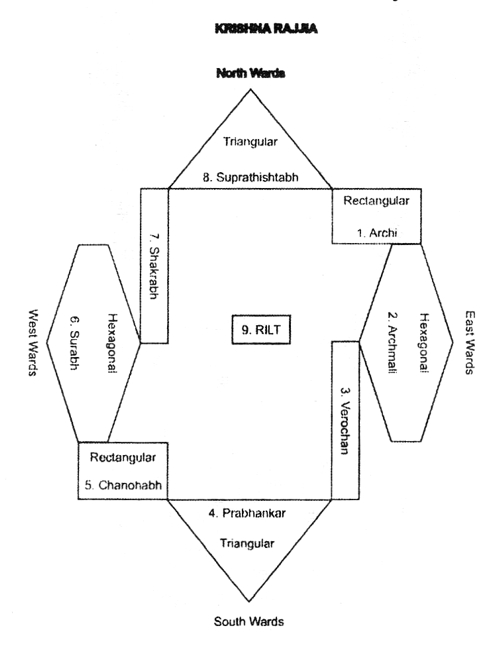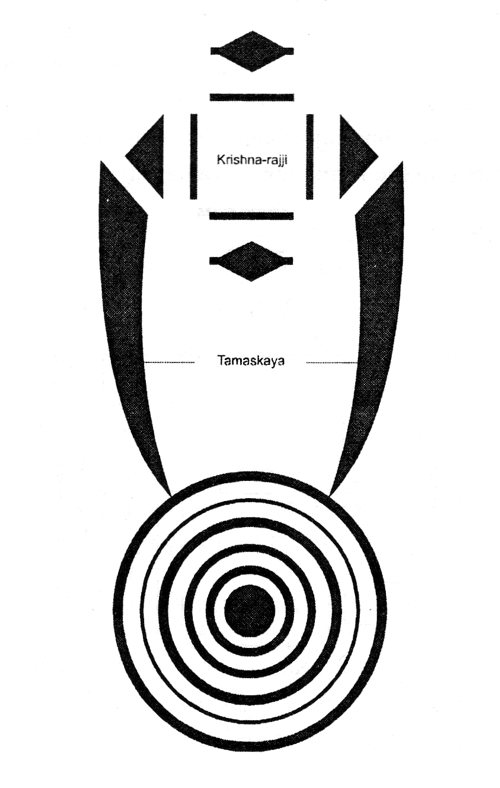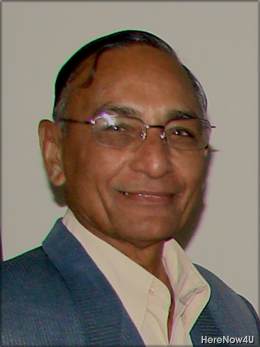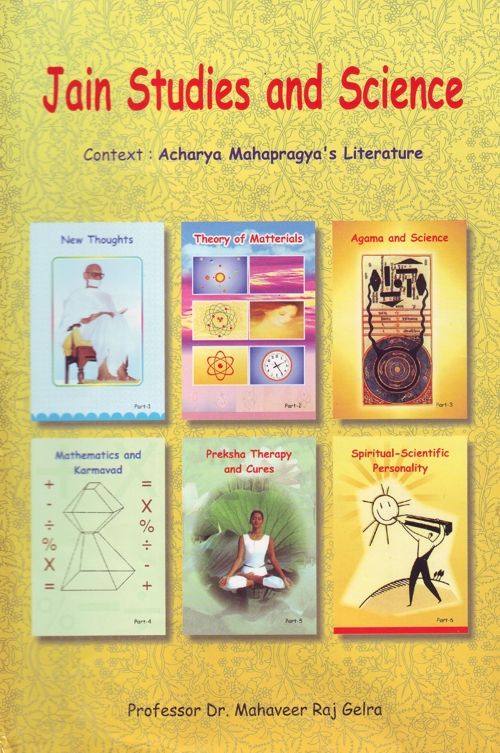The book has so far dealt with the aspects of Jain canon which have been truthfully tested on the anvil of science. Particularly, the intangible world of Sukshma (micro-) has found a strong alibi in the form of modern physics. Yet, science has not been able to surmount various frontiers which were conquered by the ancient Jain ascetics. Jain knowledge throws several such challenges to modern science. The incidences mentioned in Jain scriptures sound like any science-fiction, but then, there is a very thin line between the fact and fiction. May be the descriptions look like fantasies, yet coming from an authentic source, we have but one option to take a serious note of it.
1. Bhavitatma And its Extraordinary Powers
Bhavitatma is a typical Jain epithet which is employed for a 'super human bio' equipped with super natural powers including the capabilities of space travel and transformation of body shape into any desired form. They are often competent enough to acquire Avadhigyan by virtue of which they can know past, present and future. Bhavitatma, as the word suggests, is a soul whose resolve achieves great heights by practicing restraint, equanimity and penance. As a bio breaks the barriers of Knowledge Obscuring Karma, it reaches to the higher echelons of understanding. At this stage of awakening, bio may adopt to diverse directions -
- Sanvratatma - A bio that uses the knowledge for freedom from all passions and desires. It is a world-weary, dispassionate state of enlightenment.
- Bhavitatma - A bio that uses the acquired knowledge to gain worldly benefits. In such a state, it exhibits its might and power in various ways.
- At present, these techniques have been lost in the oblivion of time, but their description in Bhagwatisutra is worth mentioning for the readers.
In Jain belief, celestial deities have a bodily structure termed as Vaikriya, i.e. flexible and fluid body. Their bodies are like clouds which can be given any shape as per the desire of the soul possessing it. While celestial souls have this ability by virtue of their status as a deity, the worldly human souls can acquire this talent by practicing the occult science of penance and mental training. Such human soul, Bhavitatma, can utilize the Sukshma pudgals (micro matter and particles) to construct various body forms.
In practicing this morphology, a Bhavitatma can -
- Clone thousands of look alike objects,
- Over power another bio and direct it to act according to his wishes and commands, like in the cases of hypnotization,
- Create the jugglery of morphing multiple shapes of deception. Utilizing the infinite micro particles which are readily available in the universe, the magic of morphing either a male or a female shape, or that of any object like, sword, shield, flag etc.
This is an interesting world of Shukshma pudgals. Mention of seven possible ways through which the soul of a bio can expand suddenly (Samudghat) is available in Jain mythology. These are - Vedna, Kashaya, Mamantik, Vaikriya, Tej as, Aharak and Kevali. Out of these seven modes of soul's expansion, Vaikriya Samudghat is attributed to the process of morphing and cloning. Its methodology can be understood in four steps -
Step I - Soul has innumberable Pradesh. To accomplish the formation of desired shape, bio exercises Vaikriya expansion, in which some Pradesh of soul are deployed outside the body. Since remaining Pradesh of soul keeps on residing with the parent body, bio can still function normally with its Audarik Sharir - human body.
Step II - Excreted Pradesh of soul now form a temporary shape, typically known as 'Dand'. This shape helps to execute the third step.
Step III - 'Dand' now refines the available Shukshma pudgals available all around. This process of refinement segregates the useful pudgals, typically named as Ratnas (jewels), from the lot.
Step IV- The useful dions and quadons now available in concentrated form are moulded in the desired shape by the second bout of Vaikriya activity.
Mahapragya, as habitual to bring in scientific aspects, has compared this phenomenon with the properties of Laser beams by which several shapes can projected. A very recent experiment has revealed that any object can be made invisible by use of microwave radiations. We know that any object is visible due to light falling on it and reflecting up to the eyes. In this reported experiment, a shield of microwave radiation (which is beyond vision) is created around an object such that the light was prevented to fall upon it. The light now slips around this shield rendering the object invisible. We, therefore, derive that the refined Shukshma pudgals can be deployed both ways - (i) to create visibly deceptive shapes and (ii) to shield object to render it invisible.
Though the Jains stress that a bio with such an enhanced knowledge is prudent enough not to use its capabilities as jugglery, however, sporadic references are available in the literature to suggest that a few Bhavitatma used this rare knowledge of morphology. In Sthanang-Sutra such super human bios are termed as 'Riddhiman'. In Suyogado, descriptions are available regarding bios capable of reading the thoughts of others. They are referred to as 'Shrut-Bhavitatma'. In Bhagwati-Sutra, various descriptions of 'Riddhi' (extraordinary capabilities) acquired by Bhavitatma are mentioned, however, such accomplished souls are invariably considered dispassionate and they seldom use their superior powers.
1.2. Bhavitatma and Space TravelAs the acquisition of knowledge becomes intense, a soul is adorned with the capability to utilise the Shukshma pudgals (micro particles) as per its desires. Its ability to refine the surrounding Shukshma pudgals and to deploy them as per its will results in an amazing capacity to undertake space travels by Bhavitatma. Those hermits, who practice right penance, are categorised as Vidyacharan and Janghacharan. Though both are competent to undertake space travel, their relative proficiencies are varied. For deities of heaven, such a capability is universal.
Vidyacharan Sadhu - Bhagwati-Sutra throws light on how such sages attain this capability? It is mentioned that the incessant recitation of holy sutras and alternate fasting for long periods of time, annul their 'knowledge obscuring karmas' and resultantly they are blessed with the art of space travel. The alternate fasting involves abstaining from food for two continuous days and then meals intake for a day. The speed of a Vidyacharan Sadhu is equivalent to the speed with which the heavenly deities travel the peripheral distance of around three lakh sixteen thousand yojans within a jiffy. The single leap at this speed carries a Vidyacharan to Manushotar Mountain. Second leap lands directly at Nandishwar Island. During the return journey, Manushotar Mountain is used as a stop over. Similarly, for the round trip to Meru Mountain, Nandanvan is used as a mid-way stepping stone.
Janghacharan Sadhu - Sages of this stature are seven times faster than the Vidyacharan. Their alternate fasting involves abstaining from food for three continuous days and then meals intake for a day. This cycle is repeated for sufficiently long durations till the desired results are achieved by the bio. In a single run, a Janghacharan can reach the fourteenth Ruchak Pradesh and has to rest at Manushotar Mountain only during the return. He possesses additional startling capabilities - can sport even the edge of a sword without being pierced by it, can travel along the light beams of sun, can run four feet above the ground etc. These are all examples of micro particles being deployed to achieve something which is otherwise impossible. These difficult experiments are worth comparing with the modern age space travel, as this comparative study can open new vistas for the scientists.
1.3. Spacecraft and Space VoyageHumans and other living beings cannot survive beyond the earth's atmosphere. The space travels undertaken are with the help of specially designed spacecrafts where suitable pressure, temperature and oxygen levels are maintained. From the view point of biological survival, the space can be divided as -
The troposphere starts at the Earth's surface and extends 8 to 14.5 kilometers high (5 to 9 miles). This part of the atmosphere is the densest. Higher in this layer, the temperature drops from about 47 to -52 degrees Celsius. Almost all weather changes take place in this region only.
The tropopause separates the troposphere from the next layer. The tropopause and the troposphere are known as the lower atmosphere. Humans can barely survive up to 8-9 Km above sea level, beyond which the low temperature, low pressure and low oxygen make it impossible to sustain.
The stratosphere starts just above the troposphere and extends to 50 kilometers (31 miles) high. Compared to the troposphere, this part of the atmosphere is dry and less dense. The temperature in this region increases gradually to -3 degrees Celsius, due to the absorption of ultraviolet radiation. The ozone layer, which absorbs and scatters the solar ultraviolet radiation, is in this layer. Ninety-nine percent of "air" is located in the troposphere and stratosphere. The stratopause separates the stratosphere from the next layer.
The mesosphere starts just above the stratosphere and extends to 85 kilometers (53 miles) high. In this region, the temperatures again fall as low as -93 degrees Celsius as altitude increases. The chemicals are in an excited state, as they absorb energy from the Sun. The mesopause separates the mesophere from the thermosphere.
 The thermosphere starts just above the mesosphere and extends to 600 kilometers (372 miles) high. As the altitude increases, the temperatures go up due to the Sun's energy. Temperatures in this region can go as high as 1,727 degrees Celsius. The pressure is as low as 10-7 mm to 10-14 mm. Negligible gravitation is hallmark of this region.
The thermosphere starts just above the mesosphere and extends to 600 kilometers (372 miles) high. As the altitude increases, the temperatures go up due to the Sun's energy. Temperatures in this region can go as high as 1,727 degrees Celsius. The pressure is as low as 10-7 mm to 10-14 mm. Negligible gravitation is hallmark of this region.
Beyond the Atmosphere, the exosphere starts at the top to the thermosphère and continues until it merges with interplanetary gases, or space. In this region of the atmosphere, Hydrogen and Helium are the prime components and are only present at extremely low densities.
Space travel thus is possible only if the lower atmosphere type conditions of air can be artificially created inside a spacecraft. It is thus intriguing as to how be it possible for an accomplished saint to undertake space travels on his own?
An interesting explanation is found in the comments on Bhagwati-Sutra by Mahapragya. As we derive clearly from the above discussions on atmosphere, all the properties of pressure, temperature and the presence of oxygen are attributed to the 'air', termed as Vayukaya in Jain parlance. It is quite possible that the sages could segregate the useful shukshma pudgals (micro particles) from the 'air' and form a protective shield around them.
2. Krishnarajji, Tamaskaya and Black HoleAnother aspect of Jainology is its deep understanding of universe and its outlay. The descriptions of Krishnarajj i and Tamaskaya find striking resemblances with the celestial objects called Black holes by the modern physicists.
We have gazed the stars of our galaxy and amazed by their twinkling. They appear small and stationary due to the astronomical distances. In fact, they are mammoth in size, even many times bigger than our sun, and revolve at a tremendous speed. This revolution baffled the astronomers as mathematically they must be balanced around a centre with an extremely powerful gravitational pull. For, several years, such a centre eluded its presence from the eyes of most penetrating telescopes till the scientists at Max Plank Institute, Germany discovered highly dense concentration of dark cosmic dust. Such areas were totally dark and were named Black Holes by the American scientist John Wheeler in 1969. Lot of interesting findings are pouring in since last 30-40 years of incessant efforts by the astrophysicists across the globe, but the enigma is far from being resolved. Two names, Tamaskaya and Krishna-rajji, found in Jain canonical texts designate such celestial bodies whose characteristics have resemblances with the concept of Black-hole. It makes for a good comparative study.
2.1. Krishna-rajjiAccording to the Jain Agam. Bhagwati-Sutra, a group of rocks situated at the far end of the universe have two triangular, two hexagonal and four rectangular shapes arranged in geometry as shown below. These rocks are stark black and their dark shadow spreads over the entire square space in which they are situated. This arrangement looks like a boxing rink and they form such an intricate network of passages and maze of cavities that it is difficult to come out of this labyrinth. Krishna-rajji manifests tremendous force of attraction, which is instrumental in the formation of Tamaskaya.

Its description as available in Thanam Agam is as follows -
"Arunavar Island is separated by innumerable intervening islands from the Jambu Island. At the outermost periphery is situated Arunavar ocean. Travelling 42 thousand Yojans in this ocean towards the edge, there raises a layer of apkaya pudgals (fine particles predominantly containing water) which expands after rising around 1721 yojans. These layers rising from all around the outer edge look like lotus leaves and extends up to the region of Krishna-rajji. Encompassing four pantheons (devlok) including Saudharma, Tamaskaya reaches up to the Rishta limit of the fifth devlok. Fine matter forming the Tamaskaya is abounding in dark characteristics. No other matter in lok is darker than the Tamaskaya. Its darkness stuns even the deities of heaven and they abstain from these regions of Tamaskaya fearing the entrapment. It is like an imprisonment for them. Jains believe that the stars are vehicles of heavenly deities and Tamaskaya is so dark that its eddy currents can engulf even biggest stars. This brings us to a very interesting possibility of comparing these Jain cosmic entities of Krishna-rajji and Tamaskaya with the modern concept of black holes.

By definition, a Black-hole is a dead star whose gravitation is so intense that even the light photons cannot escape from it. Absence of light makes them 'black' and the way they gulp down other stars in their vicinity identifies them as 'holes'. Just a few years back, we knew our universe to be consisted of galaxies having stars, planets and moons as their family members. Of late, the presence of innumerable Black-holes has been confirmed beyond doubt.
It would be easier to understand a Black-hole, if the process of its creation is known. A star is born when the hydrogen atoms accumulate and starts off the process of nuclear fusion. As a result, the gravitational force remains in equilibrium with the heat generated. As the fuel of the star nears exhaustion, it cools off and the equilibrium of gravitation and heat is broken. With reduced heat, the gravitation takes over and the gases formed by the constant burning of nuclear fuel collapse inwards. Volume of star starts shrinking and more and more gases try to accommodate in the reduced space. This leads to increased density and therefore enhanced gra\ itation. which, in turn, attracts more mass within progressa el\ reducing volume. A cumulative process or chain reaction thus sets up. at the end of which the gravitation becomes so intense that the entire remaining gases collapse towards the dense centre with tremendous lightening, called Super Nova. The star is now dead and becomes its own crematorium. This ball of dense mass is called Black-hole. Its gravitational pull becomes so strong that even the massless photons cannot travel out of it and thus it becomes invisible. Astrophysicists could detect these Black-holes only by indirect evidences.
Mahapraya has elaborately commented on the Tamaskaya and black holes in his writings on Bhagwati-Sutra. His endeavour for the blending of ancient knowledge with modern science is highly commendable.

 Dr. Mahavir Raj Gelra
Dr. Mahavir Raj Gelra

